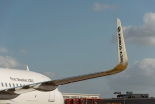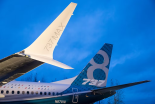Penso possa essere interessante un thread (leggero!) nel quale racchiudere info riguardanti gli aspetti meno noti e pure assai presenti nel volare quotidiano su apparecchi di cui spesso sappiamo poco o nulla; in questo senso si possono condividere articoli ed ascoltare i commenti dei piu' esperti tra noi, ai quali magari porre altre domande!
Ho appena letto questo articolo dy Sympleflying inerente l'aerodinamica applicata alle winglets, con il relativo -notevole- beneficio in termini di fuel-burn reduction.
Why Boeing Has Winglets And Airbus Has Sharklets
BYSIMPLE FLYING STAFF
UPDATED 5 DAYS AGO
Comparing the designs of the two manufacturing powerhouses.

Photo: Airbus
If you have ever looked at an aircraft, you might have noticed a variety of designs on the end of aircraft wings. These are called winglets on Boeing aircraft and Sharklets on Airbus aircraft, and both provide a significant role in reducing drag. How do they work, and what is the difference? Let's explore.
The problem with wingtips
From canted to blended, there are numerous types of winglets across the industry. Regardless, they all have a common goal. Before we dive into the difference between winglets and Sharklets, we need to understand why either exists.
When an aircraft flies, its wing creates a difference in air pressure. The air pressure above the wing is lower than air under the wing, generating lift (and the whole system of flight). However, as the wing trails off into a tip, the two pressure zones meet, and the confluence creates a series of spiraling vortexes.
The larger the vortexes, the more drag is created, slowing the aircraft down. As the plane slows down, the engines need to burn more fuel to maintain speed, costing the airline more money to operate.
Thus, airlines and aircraft manufacturers are motivated to modify wingtips in a way to reduce the size of generated vortexes. Blending a curve into the wingtip has shown to impact the size of the vortex significantly, narrowing the air turbulence diameter significantly.

A Boeing 787 MAX Winglet. Photo: Getty Images
The creation of winglets
In 1973, the Middle-Eastern oil crisis hit the aviation industry. Aircraft fuel became a premium commodity, and airlines suddenly found themselves measuring every drop. They accurately predicted that fuel would become more expensive and that they needed in kind to operate more fuel-efficient aircraft.
In partnership with NASA, aircraft manufacturers like Boeing started to experiment with ways to reduce drag and make fuel last longer. They notice that when it came to nature, birds of prey had feathered wingtips that curved up and back at the end of their wings. This generated more lift and reduced drag.
What about Airbus' Sharklets?
In 2002, the European Union started a program called the Aircraft Wing with Advanced Technology Operation (AWIATOR). This program would look at ways to reduce drag and the fuel burn of aircraft, as well as examining noise and aircraft wakes. Airbus had been experimenting with winglets since 2000, but by 2006 wasn't yet convinced in the technology.
Notably, there are exceptions within the industry. For instance, the Boeing 787 Dreamliner doesn't have winglets. The aircraft's wings were already efficient enough when designing and didn't need to require the extra weight.
What is the difference between the two?
There is no real difference between the two types of winglets apart from cosmetics. They are so close in design (that Airbus was proven to be infringing on a patent) that no version is better than another.
However, winglets and Sharklets are both solutions to inefficient wing design from earlier aircraft. A well-designed wing resolves the pressure difference as the wing ends and thus doesn't need anything on the end of the wings. With up to 33% fuel savings to be had, such innovations will go a long way, especially in today's sensitive climate.
Source: The Flying Engineer
Ho appena letto questo articolo dy Sympleflying inerente l'aerodinamica applicata alle winglets, con il relativo -notevole- beneficio in termini di fuel-burn reduction.
Why Boeing Has Winglets And Airbus Has Sharklets
BYSIMPLE FLYING STAFF
UPDATED 5 DAYS AGO
Comparing the designs of the two manufacturing powerhouses.

Photo: Airbus
If you have ever looked at an aircraft, you might have noticed a variety of designs on the end of aircraft wings. These are called winglets on Boeing aircraft and Sharklets on Airbus aircraft, and both provide a significant role in reducing drag. How do they work, and what is the difference? Let's explore.
The problem with wingtips
From canted to blended, there are numerous types of winglets across the industry. Regardless, they all have a common goal. Before we dive into the difference between winglets and Sharklets, we need to understand why either exists.
When an aircraft flies, its wing creates a difference in air pressure. The air pressure above the wing is lower than air under the wing, generating lift (and the whole system of flight). However, as the wing trails off into a tip, the two pressure zones meet, and the confluence creates a series of spiraling vortexes.
The larger the vortexes, the more drag is created, slowing the aircraft down. As the plane slows down, the engines need to burn more fuel to maintain speed, costing the airline more money to operate.
Thus, airlines and aircraft manufacturers are motivated to modify wingtips in a way to reduce the size of generated vortexes. Blending a curve into the wingtip has shown to impact the size of the vortex significantly, narrowing the air turbulence diameter significantly.

A Boeing 787 MAX Winglet. Photo: Getty Images
The creation of winglets
In 1973, the Middle-Eastern oil crisis hit the aviation industry. Aircraft fuel became a premium commodity, and airlines suddenly found themselves measuring every drop. They accurately predicted that fuel would become more expensive and that they needed in kind to operate more fuel-efficient aircraft.
In partnership with NASA, aircraft manufacturers like Boeing started to experiment with ways to reduce drag and make fuel last longer. They notice that when it came to nature, birds of prey had feathered wingtips that curved up and back at the end of their wings. This generated more lift and reduced drag.
In 1988, Boeing was the first to offer winglets with its Boeing 747-400 (called the angled winglet), but it wasn't until Gulfstream implemented a 'blended winglet' design that the technology took off. Boeing would partner with blended winglet creators Aviation Partners and implement the new design in its 737, 757, and 767 programs and offer them retroactively to existing customers.For many years, wing designers have attempted to reduce the induced drag component by special shaping of the wing tips. The Wright Brothers used curved trailing edges on their rectangular wings based on wind tunnel results. On modern airliners, the wing tips are often bent up to form winglets. Winglets were wind tunnel tested and computer analyzed by Richard Whitcomb of the NASA Langley Research Center in the mid 1970's...
"Flight tests at the NASA Dryden Flight Research Center have found a 6.5% reduction in the fuel use of a Boeing 707 type airliner when using winglets. Winglets must be carefully integrated into the total wing design, which explains why many different winglet designs appear on various airliners." - NASA.
What about Airbus' Sharklets?
In 2002, the European Union started a program called the Aircraft Wing with Advanced Technology Operation (AWIATOR). This program would look at ways to reduce drag and the fuel burn of aircraft, as well as examining noise and aircraft wakes. Airbus had been experimenting with winglets since 2000, but by 2006 wasn't yet convinced in the technology.
In 2011, Airbus finally began to offer its version of winglets, called Sharklets. Aviation Partners would sue Airbus, claiming that they used experiments with the original blended winglet design to come up with its model. In the end, Airbus lost the lawsuit and paid out an undisclosed sum to Aviation Partners."[The] latest information on the A320 winglet testing is that the results indicate that although improvements were found in terms of cruise drag, the increase in structural weight that would be necessary to support the winglets largely offsets the gain". - Airbus in 2006.
Notably, there are exceptions within the industry. For instance, the Boeing 787 Dreamliner doesn't have winglets. The aircraft's wings were already efficient enough when designing and didn't need to require the extra weight.
What is the difference between the two?
There is no real difference between the two types of winglets apart from cosmetics. They are so close in design (that Airbus was proven to be infringing on a patent) that no version is better than another.
However, winglets and Sharklets are both solutions to inefficient wing design from earlier aircraft. A well-designed wing resolves the pressure difference as the wing ends and thus doesn't need anything on the end of the wings. With up to 33% fuel savings to be had, such innovations will go a long way, especially in today's sensitive climate.
Source: The Flying Engineer
